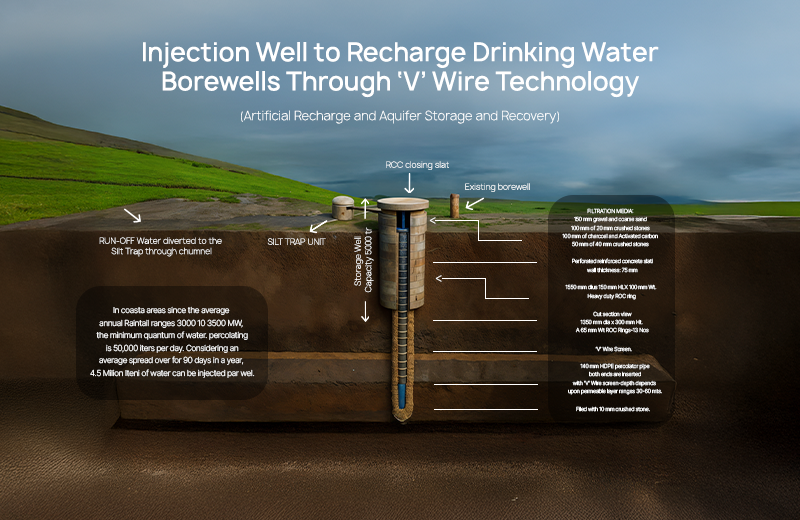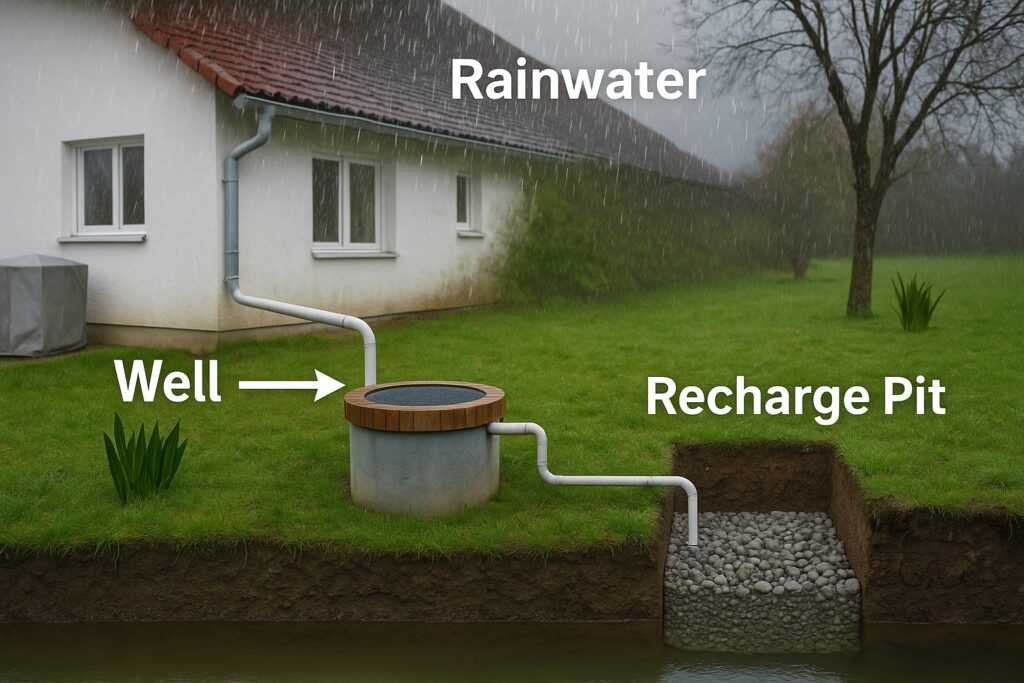25 Jun 2025
Recharge Wells and Rainwater Harvesting

A recharge well is an artificial construction which is used to supplement groundwater by directing surface water or rainfall into underlying aquifers. Recharging a well is the practice of intentionally diverting harvested rainfall into wells and restoring the aquifers that have been depleted by over-pumping.
Wells can be filled with rainwater in two most common ways:
 Recharge wells play a vital role in addressing India’s growing water crisis. As a result of rising urbanisation, irregular patterns of rainfall and heavy exploitation of groundwater, the rate at which the groundwater is exploited has surpassed the rate at which it can naturally be recharged by naturally occurring aquifers. Recharge wells offer a feasible and viable solution, pushing the surface water, particularly rain water, into the ground to replenish underground waters.
Recharge wells play a vital role in addressing India’s growing water crisis. As a result of rising urbanisation, irregular patterns of rainfall and heavy exploitation of groundwater, the rate at which the groundwater is exploited has surpassed the rate at which it can naturally be recharged by naturally occurring aquifers. Recharge wells offer a feasible and viable solution, pushing the surface water, particularly rain water, into the ground to replenish underground waters.
 Main Components
Main Components

Rainwater can be harvested and recharged in groundwater in diverse ways, including rooftops, open surfaces, and stormwater drains. After it has been gathered, the water must be forced through filtering systems such as silt traps or first-flush devices to take out large debris and contaminants. The filtered water is then channelled into recharge basins like specially built wells, infiltration pits, trenches or percolating ponds. Such systems ensure that water percolates into the underground and recharges aquifers. To keep it effective and safe, it is recommended to perform regular maintenance of the filtration units and check the quality of the recharged water in the ground regularly.
Does borewell recharge work?
It is true; its effectiveness is proven by numerous real cases. In Hubli, farmers regained the usable borewells. Reported yields of individual cases are 6 to 16 hours daily. Other organisations, such as SRDS and SIF, recharged hundreds of borewells with measurable increases in water quantity and quality.
- Rooftop Rainwater Harvesting - Gutters and downpipes are used to collect filtered roof run off, which is then deposited into a recharge well.
- Rain Pits by the Well - Digging pits by the side of the well where the rain water can be collected and percolated.
Purpose and Importance
India has a dire drinking water problem, considering it is among the biggest recipients of rain globally. Groundwater levels have been drastically reduced due to population growth, urbanisation and poor water management. Due to this, conservation practices of rainwater, such as providing recharge wells, have never been more essential.Annual Rainfall in India and Water Shortage
The majority of rainfall in India comes during the monsoon (June to September); however, this deluge of rain fails to address the chronic water scarcity. Lack of proper storage, minimal recharging efforts and large extraction volumes contribute to the reasons. There is a need to address this paradox by sustainable measures like adopting rainwater harvesting and artificial groundwater recharge.Why We Need Recharge Wells
 Recharge wells play a vital role in addressing India’s growing water crisis. As a result of rising urbanisation, irregular patterns of rainfall and heavy exploitation of groundwater, the rate at which the groundwater is exploited has surpassed the rate at which it can naturally be recharged by naturally occurring aquifers. Recharge wells offer a feasible and viable solution, pushing the surface water, particularly rain water, into the ground to replenish underground waters.
Recharge wells play a vital role in addressing India’s growing water crisis. As a result of rising urbanisation, irregular patterns of rainfall and heavy exploitation of groundwater, the rate at which the groundwater is exploited has surpassed the rate at which it can naturally be recharged by naturally occurring aquifers. Recharge wells offer a feasible and viable solution, pushing the surface water, particularly rain water, into the ground to replenish underground waters.
- Solving the Problem of Water Scarcity: Water is a perennial problem in India, both in urban and rural sectors. Most of this problem is attributed to the overuse of borewells and the shrinking groundwater tables. Recharge wells are useful in stabilising groundwater levels by repumping rainwater harvested into the aquifers. Even the overuse is offset by this recharging process and maintains the water table.
- Healthy Aquifers: A healthy aquifer would be a natural reservoir that stores water, which can be accessed even in the dry season. Through recharging wells in the rainy season, communities make sure they have sufficient groundwater during dry periods or in summer when their surface-water sources are exhausted.
- Sustainable Water Management: Recharge wells help promote long-term and balanced water consumption. Communities and households can use recharge wells to replenish local aquifers instead of external water suppliers like a tanker or municipal supplies. This allows more decentralised, self-reliant and environmentally friendly water management.
Recharge Wells Benefits for Households, Agriculture and Communities
The effects of recharge wells are beneficial and spread to single households, agricultural lands, and even the whole society, bringing economic and environmental benefits.- Restoration Water Table around the area: The immediate positive effect of a recharge well is the rejuvenation of old wells and boreholes. The water table around the recharge structures increases as rainwater is channelled towards the ground. This is particularly helpful in areas where borewells have dried up as a result of overuse or an extended period of drought.
- Drought Resilience: Regions that have recharge systems installed can endure droughts or water shortages. When the groundwater level improves, farmers will be able to sustain irrigation of crops, and households will have a steady supply of water. This reduces the reliance on costly water tankers or government relief during a drought.
- Environmental Benefits: Recharge wells enable rainwater to infiltrate into the ground, and minimise surface run. Not only does this avoid wastage of water, but it also greatly reduces the probability of urban flooding, especially in high population areas where storm drains tend to become overwhelmed. In addition, water tables provide vegetation around the area, which maintains biodiversity in the area.
- Community Impact: A rRecharge well will have a good communal impact as the facility will guarantee the availability of groundwater for local agriculture, sanitation and household needs. In agricultural zones, improved water supply increases agricultural production, stabilises the business of farmers, and promotes food security. Recharge systems in an urban environment are capable of relieving the pressures on urban water supply and encouraging communal ownership of sustainable water usage.
Best Season to Use Recharge Wells
Recharge wells are most helpful in the monsoon season when rain is in plenty. It should be installed just before the onset of the rains. Monsoon patterns are different in different parts of India, so to maximise effectiveness, it is best to synchronise the builds with the local weather.How Recharge Wells Work
Fundamental Principles of Groundwater Recharge
Groundwater recharge process is the process in which water goes into the soil and replenishes aquifers. Artificial recharge structures speed up this process by trapping rainwater, cleaning it and assisting it to seep through.Two Primary Recharge Techniques
A: Recharge Wells Using Rainwater Harvesting from the Rooftop
 Main Components
Main Components
- Catchment Area (Rooftop): One that collects rainwater.
- Conveyance System: A system that conveys rainwater efficiently to the recharge well using our rainwater gutter systems.
- Filtration: It filters large debris and silt using first-flush diverters or an in-drain trap.
- Recharge Well: It accepts and sends the filtered rainwater into underground aquifers.
Method of Construction
A stepwise description is as follows: Step 1: Selecting the Site – It should be close to the borewell, away from soak pits or buildings. Step 2: Dig the Well – Usually 3 ft (0.9 m) wide and 20 ft (6 m) deep; supported by reinforced concrete rings. Step 3: Add Filtration – Set up a first-flush diverter and in-drain silt trap. Step 4: Connect Conveyance – Connect the gutters or downpipes of the house to the recharge well. Step 5: Fit the Slab and Cover – Install the RCC slab with manhole and safety grill covers. Step 6: Backfill Around Rings – Backfill 4 to 5 inches with gravel or jelly stones (40 mm) to stabilise the rings and speed up percolation.Applications
- Domestic - Homes that want to refill borewells or wells.
- Agricultural - In farms, so they are not hit by seasonal depletion.
- Commercial/Institutional - Schools, offices, malls, hospitals, hoping to achieve sustainability.
B. Recharge Wells with Rain Pits near the Well
When & Why
Rain pits are recommended where the line of action for redirecting roof water is not feasible, but surface runoff can certainly be intercepted and diverted into adjacent recharge systems.Construction Details
Dimensions: Roughly 2 m × 2 m × 2 m- Filling Materials: Several layers containing coarse sand, charcoal, gravel, and pebbles to facilitate infiltration.
- Filter Pit Setup: A concrete ring set containing HDPE Pipe perforated with holes, surrounded by gravel and a fine silt trap to purify the entering water.
- Connectivity: Channels from rooftops, drains, or fields are of various forms to transport the water into the pit.
Case Studies
- Hubli Farm – Chitranjan Kallannavar had borewells remaining full continuously for a year after recharging.
- Devendrappa Basti – The recharge revived flow to his well for 16 hours per day, post an investment of ₹11,665.
- SRDS – The organisation claims that “once recharged, a borewell never goes dry,” benefiting farmers in seven Indian states.
- Homes — Gutter waters from rooftops flow to a 3-ft well with a simple filtering process and slab covering.
- Farms — Bigger pits, usually with diversion channels from fields.
- Institution — Campus may consist of several recharge wells sized according to the drainage area and supplemented with storage tanks.
Maintenance Guidelines and Precautions
- Outside checkups: Inspect filters and piping before and after the monsoon.
- Cleaning of Filters: Empty silt traps and clean gravel beds after each season.
- Water Quality Check: Test for bacterial or chemical contamination at least yearly when recharge wells are used for indirect drinking water purposes.
- Seasonal Tasks: Remove leaf debris, backwash diverters, clamp slabs and covers.
Common Mistakes to Avoid
- Poor site selection: Too close to septic areas or building foundations.
- Inadequate filtration: This can cause clogging or contamination.
- Bypassing maintenance: Will silt up the system and reduce operational efficiency.
Difference Between Recharge Wells and Storage Tanks

| Aspect | Recharge Well | Storage Tank |
| Purpose | Replenishes aquifers. | Holds water for direct use. |
| Construction | Excavated wells/ rings with percolation media. | Requires waterproof tanks (underground/above). |
| Water Quality | Slightly filtered; groundwater use. | Higher, near potable (water treatment). |
| Maintenance | Remove silt, inspect downpipes. | Clean tanks, maintain gutters and seal. |
Environmental Impact and Community Benefits of Recharge Wells
Recharge wells provide numerous environmental and community benefits:- Urban Flooding Reduction – These wells capture runoff or prevent stormwater from clogging systems.
- Biodiversity Support – Recharged aquifers help rejuvenate the green cover and provide for the wildlife.
- Sustainable Water Security – People have access to groundwater, reduce expenditure and reliance on external water sources.
Conclusion
Recharge wells, either fed with rooftop rainwater via gutter systems or by rain pits adjacent to wells, are inexpensive, easy to use and highly effective mechanisms of recharging groundwater. They enhance water security, strengthen community resilience, and promote economic and environmental sustainability. Designed, installed and maintained well, recharge wells can transform the water future of India, and enable communities to flourish even as scarcity continues to increase.FAQs
What is open well recharge? The concept of open well recharge is to facilitate rainwater through a source such as an existing open well (or borewell) into the ground to add to the groundwater. This may be in the form of filter pits or recharge tubes, or even direct gutter connections. How can we recharge groundwater?Rainwater can be harvested and recharged in groundwater in diverse ways, including rooftops, open surfaces, and stormwater drains. After it has been gathered, the water must be forced through filtering systems such as silt traps or first-flush devices to take out large debris and contaminants. The filtered water is then channelled into recharge basins like specially built wells, infiltration pits, trenches or percolating ponds. Such systems ensure that water percolates into the underground and recharges aquifers. To keep it effective and safe, it is recommended to perform regular maintenance of the filtration units and check the quality of the recharged water in the ground regularly.
Does borewell recharge work?
It is true; its effectiveness is proven by numerous real cases. In Hubli, farmers regained the usable borewells. Reported yields of individual cases are 6 to 16 hours daily. Other organisations, such as SRDS and SIF, recharged hundreds of borewells with measurable increases in water quantity and quality.
More blogs
Get in touch with us
Phone
1800 833 6675 
![For a very long time, India has been facing an escalating water crisis, driven by inevitable factors like climate change, population surge, and uneven distribution of rainfall, which calls for a timely and innovative solution. This is where rainwater harvesting emerges as a simple yet powerful solution. By capturing and storing rainwater for later use, […]](/_next/image?url=https%3A%2F%2Fadmin.euroguardhysquare.com%2Fwp-content%2Fuploads%2F2025%2F03%2Funnamed-4.webp&w=3840&q=100)

![Roof leakage is a very common yet underestimated issue faced by homeowners. It is something that might start off as a minor inconvenience, with a few drops of water trickling down during a heavy rainstorm. But what you need to know and understand is that if the issue remains unaddressed, it could quickly escalate into […]](/_next/image?url=https%3A%2F%2Fadmin.euroguardhysquare.com%2Fwp-content%2Fuploads%2F2025%2F03%2Froof-leakage-3.webp&w=3840&q=100)
